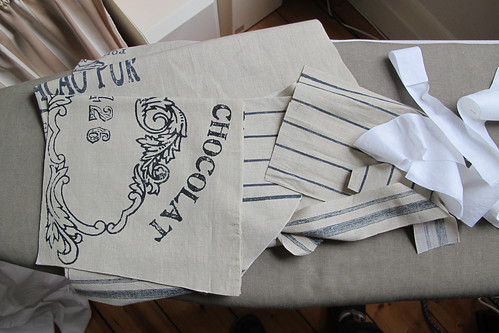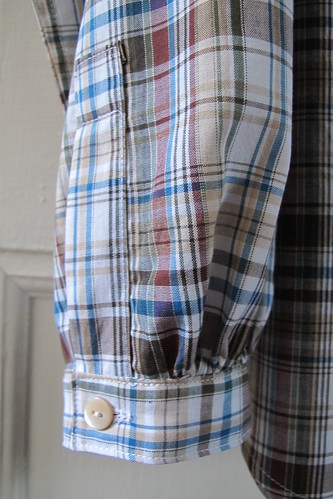This, for posterity and my non FB audience, is a rewrite of a bunch of short FB posts on progression of my sewing machine dramas. I hope I’ve caught all the necessary tense changes:
~~~~~~~~~~~~~~~~~~~~~~~~~~~~~~~~~~~~~~~~~~
I woke up the morning after this post thinking that clunky feed dog thing was a deal breaker if it couldn’t be fixed. Sproingy clunk every time I touched the knee lever, which is every few seconds of sewing. So I called the shop and told them so. They said to bring it in so they can look at it. I felt better for having got to that point.
Then there was a weekend, during which I thought I’d better check carefully to get the best understanding of the problem I could manage.
So very glad I checked before going back to the sewing machine shop. The knee lever on my old machine *does* drop the feed dogs! I’d never noticed this in all those years! However it does so much more smoothly and quietly than the new machine, and doesn’t grab and shift the work.
A careful comparison of the two machines exposed this: Two main differences were pissing me off.
1. that the feed dogs on the 570 drop with a loud, spring like reverb, whereas the old one is almost silent.
2. the new one drops the feed dogs almost instantly on pushing the lever while the old one lowers them gradually, silently and recoverably for about half the range of lever movement. Only if one pushes past half way do the dogs drop fully and have to spring back when stitching resumes. which means one can partially lift the foot, swivel the work and resume without the feed dogs intefering with fabric position. Yup, got it.
On the following Monday I took the 570 back to the shop: “There is nothing wrong with it, they all do that, no one else has complained, we sell a lot of these, there is no adjustment or fix because it’s not broken”. I was just about in tears after this conversation. I raised the possibility of a return, which they brushed off. I asked them to check two things with Bernina for me.
1. Whether there was any way to adjust the knee lever action on the feed dogs, including deactivating it.
2. If there is a needle plate available for this machine with metric seam markings at the front.
While they did this, I left the machine in the shop. I knew that if I took it with me, I might not have had the nerve to go back. Then I went and visited some friends for a couple of hours.
The answer to both questions was no. Argh. After some angst ridden thought, I decided I’d be miserable if I tried to live with it. I can’t live with such an expensive machine that makes unexpected loud sproingy noises when I use it the way I prefer to, which is supposedly a perfectly fine and recommended way to use it. So back to the shop, and returned it, as in, got my money back. Their tone had changed when I went back, polite and agreed promptly to the return. I do wonder how much of that was due to my (somewhat imposing and male) friend coming with me as back up. Regardless of whether his presence changed their behaviour, I’m grateful to him for the emotional support.
Gah, I didn’t mean, want or expect this to be such a saga. I was relieved but sad, confused and needing to start again with the search. I’m distressed that the obvious option of buying a current model Bernina is off the table.
Replacing my 1230 seems to be a truly difficult task, so putting a bit more effort into trying to keep it going is reasonable. The current state of play is that it’s with a third and recommended fixit man to see what magic he can manage. He had a nice simple theory, which would be so good if that is all the problem. Fingers crossed.
Then, a week later, my longest friend gave me even more reasons to love her. This is her machine, very kindly lent to me. I’d forgotten she even had a Bernina. It turns out to be a 1030, a mechanical version of mine, including the same knee lever action…. and wonder of wonders, it has a stepping motor!!!! AWOOGA, AWOOGA. I want one if I can possibly get one!!. Pity it’s a 30yr old machine. One might come up for sale? Maybe? There are a couple of features lacking, but it’s mechanical nature means it should last many more years. The electronic nature of mine means it will die eventually, even if it can be improved in the short term.

So far the borrowed machine has made a pair of jeans and is partway through a silk velvet jacket. The sewing action is a bit different to what I’m used to, but it works well.
Then another friend said that her sewing machine mechanic has a 1030 that he is working on prior to selling it. On the other side of the country, but still. Fingers very crossed!!
Updatery: It turns out that the 1030 is not fully mechanical. It does have a circuit board. So it’s not as age proof as I had hoped. I had been told that stepping motor and fully mechanical were if not totally mutually exclusive, then close to it. So I’m not completely surprised.









































